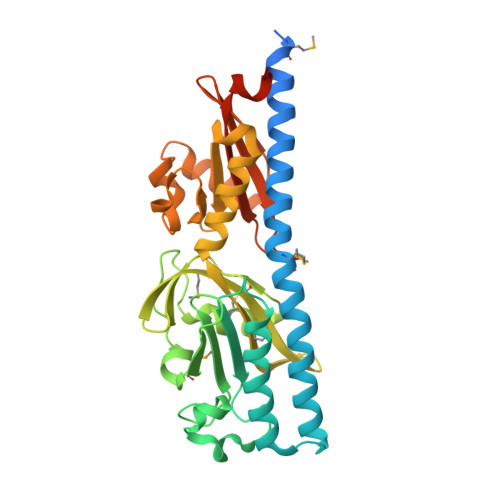High-Affinity Chemotaxis to Histamine Mediated by the TlpQ Chemoreceptor of the Human Pathogen Pseudomonas aeruginosa.
Corral-Lugo, A., Matilla, M.A., Martin-Mora, D., Silva Jimenez, H., Mesa Torres, N., Kato, J., Hida, A., Oku, S., Conejero-Muriel, M., Gavira, J.A., Krell, T.(2018) mBio 9
- PubMed: 30425146
- DOI: https://doi.org/10.1128/mBio.01894-18
- Primary Citation of Related Structures:
6FU4 - PubMed Abstract:
Histamine is a key biological signaling molecule. It acts as a neurotransmitter in the central and peripheral nervous systems and coordinates local inflammatory responses by modulating the activity of different immune cells. During inflammatory processes, including bacterial infections, neutrophils stimulate the production and release of histamine. Here, we report that the opportunistic human pathogen Pseudomonas aeruginosa exhibits chemotaxis toward histamine. This chemotactic response is mediated by the concerted action of the TlpQ, PctA, and PctC chemoreceptors, which display differing sensitivities to histamine. Low concentrations of histamine were sufficient to activate TlpQ, which binds histamine with an affinity of 639?nM. To explore this binding, we resolved the high-resolution structure of the TlpQ ligand binding domain in complex with histamine. It has an unusually large dCACHE domain and binds histamine through a highly negatively charged pocket at its membrane distal module. Chemotaxis to histamine may play a role in the virulence of P. aeruginosa by recruiting cells at the infection site and consequently modulating the expression of quorum-sensing-dependent virulence genes. TlpQ is the first bacterial histamine receptor to be described and greatly differs from human histamine receptors, indicating that eukaryotes and bacteria have pursued different strategies for histamine recognition. IMPORTANCE Genome analyses indicate that many bacteria possess an elevated number of chemoreceptors, suggesting that these species are able to perform chemotaxis to a wide variety of compounds. The scientific community is now only beginning to explore this diversity and to elucidate the corresponding physiological relevance. The discovery of histamine chemotaxis in the human pathogen Pseudomonas aeruginosa provides insight into tactic movements that occur within the host. Since histamine is released in response to bacterial pathogens, histamine chemotaxis may permit bacterial migration and accumulation at infection sites, potentially modulating, in turn, quorum-sensing-mediated processes and the expression of virulence genes. As a consequence, the modulation of histamine chemotaxis by signal analogues may result in alterations of the bacterial virulence. As the first report of bacterial histamine chemotaxis, this study lays the foundation for the exploration of the physiological relevance of histamine chemotaxis and its role in pathogenicity.
Organizational Affiliation:
Department of Environmental Protection, Estaci¨®n Experimental del Zaid¨ªn, Consejo Superior de Investigaciones Cient¨ªficas, Granada, Spain.





















